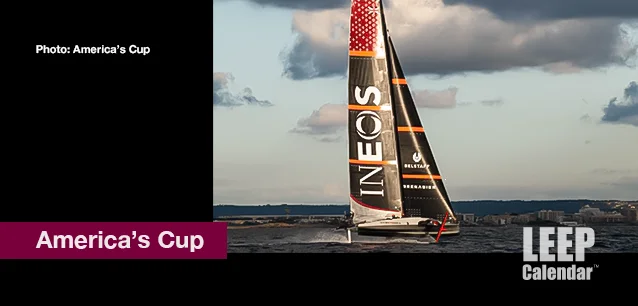 AD
AD
Today is: November 04
Scroll to explore events active on this date.
Additional Events on LEEP
LEEP INK FEATURES

August? Absolutely!
In August, we live through the Dog Days of Summer. It's hot and often humid, and those who can leave for better climates do. Down south, winter is in full force. August is also known as "the ...

In The Heat of July: July 2025 Events
Is it hot enough (or cold enough if you're below the equator) for you yet? There is actually a day for that! Like every month, I pick a diverse collection of events you may or may not know about. This ...

May Blooms: Events in May 2025
Along with October, May is one of the most densely packed months of the year. It's before the summer humidity and the last whole month of the school year. The weather is warming in t...
About the America's Cup
Competitions & Awards , European Countries
Ends: Oct 27, 2024
DESCRIPTION:
The America's Cup is one of the most prestigious and oldest trophies in international sailing, dating back to 1851. Its history, competition, and the evolution of the boats used in the race are rich and colorful.
History
The America's Cup started as a race around the Isle of Wight in England. The schooner "America" won the race, which represented the New York Yacht Club (NYYC), and the trophy was subsequently named after the winning yacht, not the country.
The NYYC held the trophy for a stunning 132 years, from 1851 until 1983, in the longest winning streak in sports history. Over the years, the competition has become an intense match between nations, attracting top sailors and designers and fostering innovations in yacht design and sailing technology.
Types of Boats
The types of boats used in the America's Cup have changed significantly over the years, reflecting technological advancements and rules shifts. Here's an overview:
Early Years (1851-1956): Initially, there were few restrictions, and various types of yachts competed, such as schooners and cutters. The main requirement was that they be seaworthy enough to cross the Atlantic.
12-Metre Class (1958-1987): From 1958 to 1987, the races involved 12-meter class yachts. These boats had a specific formula governing their design, leading to closer competition.
International America's Cup Class (IACC) (1992-2007): IACC yachts were introduced in 1992. They were larger and faster, reflecting advancements in materials and design.
Multihulls (2010-2017): In 2010, the competition shifted to multihull vessels, including trimarans and catamarans. These boats featured rigid wing sails and hydrofoil technology, enabling them to "fly" above the water at incredible speeds.
AC75 Class: The 36th America's Cup (2021) introduced the AC75 class, a 75-foot foiling monohull. These boats combine elements of both monohulls and multihulls and are capable of breathtaking speed and agility.
Conclusion
The America's Cup is more than just a yacht race; it symbolizes maritime tradition, national pride, and technological innovation. The competition has spurred advancements in naval architecture and engineering, pushing the boundaries of what's possible in sailing. The changing designs of the boats, from classic schooners to modern foiling marvels, mirror the evolution of the sport itself. The Cup continues to represent the pinnacle of sailing competition and excellence, drawing attention from around the world.
VIDEOS
ADDITIONAL IMAGES
Currently, this event does not have supporting images.
Where would you like to go now?
 AD
AD



/footer-logo.svg)
